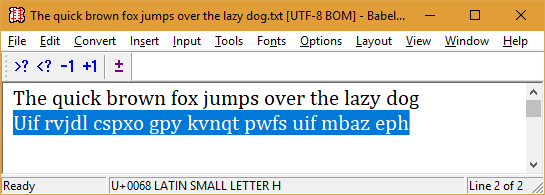
Example of the Caesar cipher in BabelPad

With BabelPad you can apply a Caesar cipher to any selected text in the BabelPad edit window. The cipher is a simple substitution cipher that shifts each letter character in the selected text by a specific shift value. For example, with a shift value of -3 the letter "M" is converted to "J", and with a shift value of +3 the letter "M" is converted to "P".
In BabelPad the Caesar cipher applies to all 125,000+ Unicode characters with a general category of "letter" (Ll, Lm, Lo, Lt, Lu), but other characters such as punctuation marks, diacritical marks, symbols, digits, private use characters, and reserved code points are left unaffected by the cipher. The cipher wraps on a Unicode block, so, for example, if you apply a +1 shift the last letter in a given Unicode block will be converted to the first letter of the same block (e.g. U+169A OGHAM LETTER PEITH will become U+1681 OGHAM LETTER BEITH). However, for Basic Latin the cipher wraps uppercase and lowercase letters separately on the ranges A..Z and a..z, so for example "Henry" shifted +3 will become "Khqub".
BabelPad allows you apply or reverse a user-specified shift value, which you can configure from the Caesar Cipher Configuration dialog box. You may open this dialog either by selecting "Set Cipher Shift Value..." from the Caesar Cipher submenu of the Convert menu, or by clicking on the rightmost button of the Cipher toolbar.
Caesar Cipher Configuration dialog box

This dialog box has two settings:
You can apply a Caesar cipher to selected text using the Caesar Cipher submenu of the Convert menu, the buttons on the Cipher toolbox, or shortcut keys.